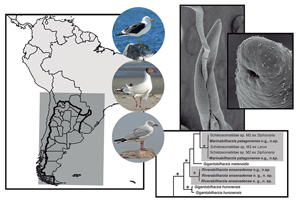Article contents
Two new genera and species of avian schistosomes from Argentina with proposed recommendations and discussion of the polyphyletic genus Gigantobilharzia (Trematoda, Schistosomatidae)
Published online by Cambridge University Press: 04 February 2022
Abstract

Gigantobilharzia Odhner, 1910 (Schistosomatidae) includes species that parasitize several orders of birds and families of gastropods from both freshwater and marine environments worldwide. Due to their delicate bodies, most of the species descriptions are incomplete, and lumped in the genus Gigantobilharzia, in some cases despite major morphological variability. Only three of those species have molecular sequence data but then lack a robust morphological description, making species differentiation very difficult. For this reason, several authors consider that many of the species of Gigantobilharzia should be reassigned to new genera. The aim of this paper is to describe two new genera and two new species of schistosomes using morphological and molecular characterization. We described Marinabilharzia patagonense n. g., n. sp. parasitizing Larus dominicanus from north Patagonian coast, and Riverabilharzia ensenadense n. g., n. sp. parasitizing L. dominicanus, Chroicocephalus maculipennis and Chroicocephalus cirrocephalus from freshwater Río de La Plata, in South America, Argentina. We then analysed and discussed the combinations of characters defining species of Gigantobilharzia and, based on that and on the available molecular data, we propose at least four possible new genera.
Keywords
- Type
- Research Article
- Information
- Copyright
- Copyright © The Author(s), 2022. Published by Cambridge University Press
Footnotes
These authors contributed equally to this article
References
- 6
- Cited by




